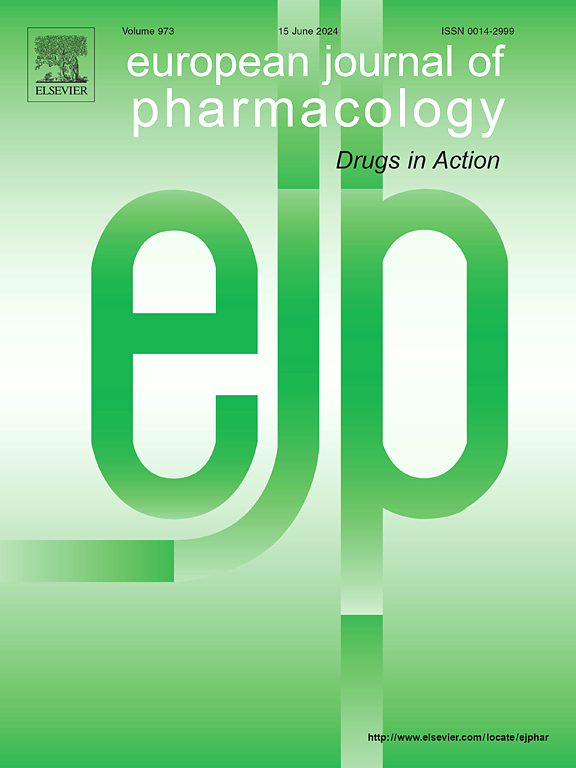Cannabinol improves exemestane efficacy in estrogen receptor-positive breast cancer models: a comparative study with cannabidiol
IF 4.2
3区 医学
Q1 PHARMACOLOGY & PHARMACY
引用次数: 0
Abstract
Cannabinoids have been used as anti-emetic agents in cancer. However, multiple studies suggest that cannabinoids present important anti-tumor actions as well. Estrogen receptor-positive (ER+) breast cancer is the most diagnosed breast cancer subtype, and despite the success of endocrine therapy, endocrine resistance development is a major challenge, demanding the discovery or implementation of alternative therapeutic approaches. In line with this, and following our previous work, the benefits of combining the aromatase inhibitors (AIs) used in the clinic, anastrozole (Ana), letrozole (Let), and exemestane (Exe), with cannabinol (CBN) were evaluated. Experiments were performed in MCF-7aro cells and spheroids to assess activity against specific molecular targets and underlying mechanisms of action. Among the three AIs studied, only the combination of CBN with Exe induced a significant beneficial impact on viability and growth of ER+ breast cancer cells and spheroids. Our results demonstrated that this combination was more effective than Exe in preventing the expression of aromatase and in modulating ERα and androgen receptor (AR) activity. In fact, the results revealed that CBN can prevent de novo synthesis of aromatase, surpass Exe's weak estrogen-like effect, and avoid the unfavorable overexpression of AR. By comparing these two therapeutic strategies, as well as the previously studied combination of Exe plus cannabidiol (CBD), differential transcriptome profiles were detected, which may help to better understand the mechanism of action of cannabinoids and disclose their full potential in breast cancer treatment. In conclusion, this study strengthens the hypothesis that cannabinoids are important anti-cancer agents with attractive co-adjuvant properties.
大麻酚提高依西美坦在雌激素受体阳性乳腺癌模型中的疗效:与大麻二酚的比较研究
大麻素已被用作癌症的止吐剂。然而,多项研究表明大麻素也具有重要的抗肿瘤作用。雌激素受体阳性(ER+)乳腺癌是诊断最多的乳腺癌亚型,尽管内分泌治疗取得了成功,但内分泌抵抗的发展是一个重大挑战,需要发现或实施替代治疗方法。根据这一点,并根据我们之前的工作,评估了临床使用的芳香酶抑制剂(AIs),阿那曲唑(Ana),来曲唑(Let)和依西美坦(Exe)与大麻酚(CBN)联合使用的益处。实验在MCF-7aro细胞和球体中进行,以评估针对特定分子靶点的活性和潜在的作用机制。在研究的三种AIs中,只有CBN与Exe联合使用对ER+乳腺癌细胞和球体的活力和生长产生了显著的有益影响。我们的研究结果表明,该组合在阻止芳香化酶的表达和调节ERα和雄激素受体(AR)活性方面比Exe更有效。事实上,研究结果表明,CBN可以阻止芳香化酶的新生合成,超越Exe的弱雌激素样作用,避免AR的不利过表达。通过比较这两种治疗策略,以及之前研究的Exe与大麻二酚(CBD)联合使用,检测出差异转录组谱,这可能有助于更好地了解大麻素的作用机制,揭示其在乳腺癌治疗中的全部潜力。总之,这项研究加强了大麻素是重要的抗癌药物具有吸引力的辅助特性的假设。
本文章由计算机程序翻译,如有差异,请以英文原文为准。
求助全文
约1分钟内获得全文
求助全文
来源期刊
CiteScore
9.00
自引率
0.00%
发文量
572
审稿时长
34 days
期刊介绍:
The European Journal of Pharmacology publishes research papers covering all aspects of experimental pharmacology with focus on the mechanism of action of structurally identified compounds affecting biological systems.
The scope includes:
Behavioural pharmacology
Neuropharmacology and analgesia
Cardiovascular pharmacology
Pulmonary, gastrointestinal and urogenital pharmacology
Endocrine pharmacology
Immunopharmacology and inflammation
Molecular and cellular pharmacology
Regenerative pharmacology
Biologicals and biotherapeutics
Translational pharmacology
Nutriceutical pharmacology.

 求助内容:
求助内容: 应助结果提醒方式:
应助结果提醒方式:


